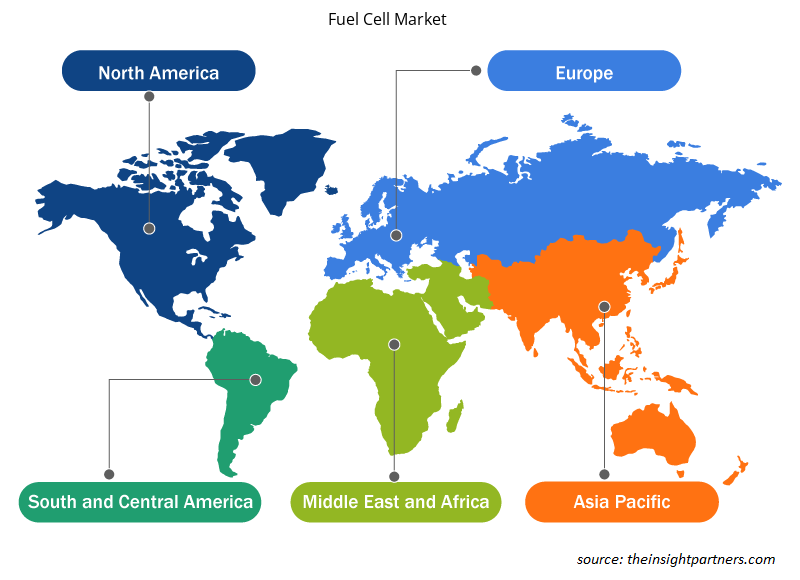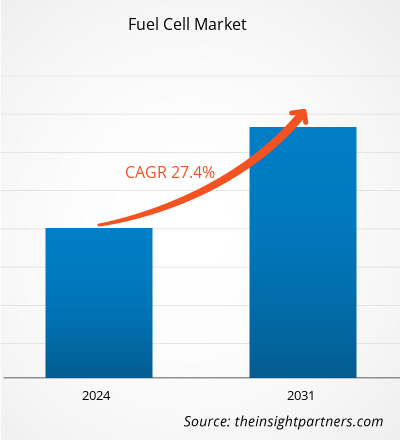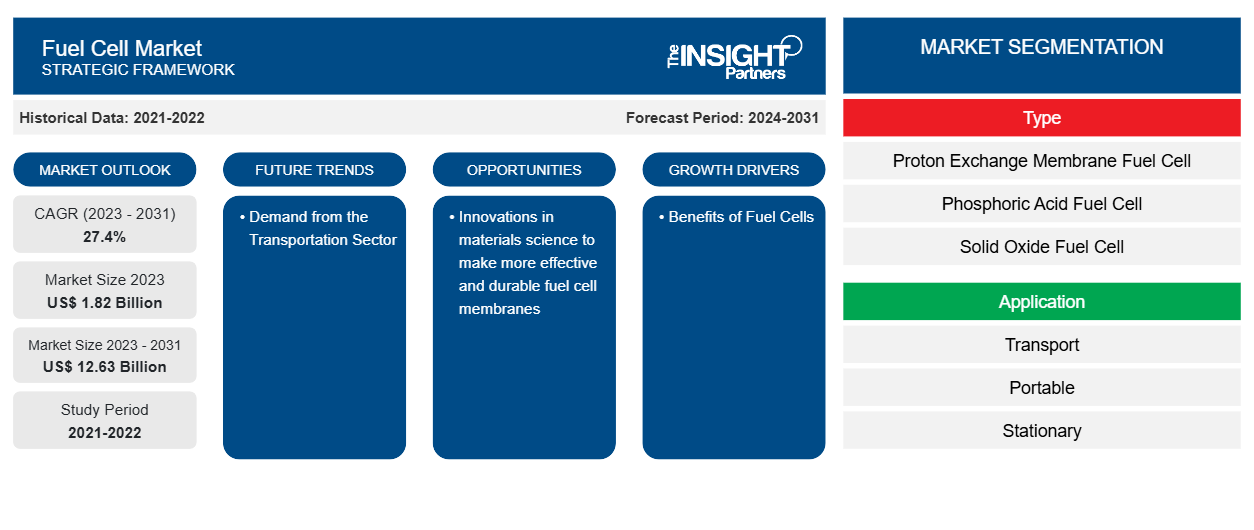Der Brennstoffzellenmarkt soll von 1,82 Milliarden US-Dollar im Jahr 2023 auf 12,63 Milliarden US-Dollar im Jahr 2031 anwachsen. Der Markt soll zwischen 2023 und 2031 eine durchschnittliche jährliche Wachstumsrate (CAGR) von 27,4 % verzeichnen. Die Vorteile von Brennstoffzellen gegenüber herkömmlichen Verbrennungstechnologien und die wachsende Nachfrage nach unkonventionellen Energiequellen dürften weiterhin der Schlüssel zu den Brennstoffzellenmarkttrends sein.
Brennstoffzellen-Marktanalyse
Die wachsende Verbrauchernachfrage nach nicht-konventionellen Energiequellen ist einer der Haupttreiber. Die Verringerung der Umweltbelastung dürfte die Nachfrage nach Brennstoffzellentechnologien ankurbeln. Es wird erwartet, dass Regierungen überall diese Fortschritte mit Unterstützung in verschiedenen Formen ergänzen werden, beispielsweise durch die Finanzierung von Forschungs- und Entwicklungsinitiativen und entsprechenden Finanzierungsprogrammen. Darüber hinaus stützen die staatlichen Initiativen und Investitionen zur Förderung des Marktes für Elektrofahrzeuge das Marktwachstum weiter.
Marktübersicht für Brennstoffzellen
Eine Brennstoffzelle erzeugt Strom effektiv und sauber, indem sie die chemische Energie von Wasserstoff oder anderen Brennstoffen nutzt. Die einzigen Nebenprodukte, wenn Wasserstoff der Brennstoff ist, sind Wärme, Wasser und Strom. Die Bandbreite der möglichen Einsatzmöglichkeiten von Brennstoffzellen macht sie einzigartig; sie können Systeme von der Größe eines Kraftwerks bis hin zur Größe eines Laptops mit Strom versorgen und dabei eine Vielzahl von Brennstoffen und Ausgangsstoffen verwenden.
Passen Sie diesen Bericht Ihren Anforderungen an
Sie erhalten kostenlos individuelle Anpassungen an jedem Bericht, einschließlich Teilen dieses Berichts oder einer Analyse auf Länderebene, eines Excel-Datenpakets sowie tolle Angebote und Rabatte für Start-ups und Universitäten.
-
Holen Sie sich die wichtigsten Markttrends aus diesem Bericht.Dieses KOSTENLOSE Beispiel umfasst eine Datenanalyse von Markttrends bis hin zu Schätzungen und Prognosen.
Treiber und Chancen auf dem Brennstoffzellenmarkt
Vorteile von Brennstoffzellen begünstigen den Markt
Brennstoffzellen können für eine Vielzahl von Anwendungen eingesetzt werden, darunter Transport, Industrie-/Gewerbe-/Wohngebäude und die langfristige Energiespeicherung im Netz in reversiblen Systemen. Brennstoffzellen haben gegenüber herkömmlichen verbrennungsbasierten Technologien zahlreiche Vorteile. Darüber hinaus werden sie in verschiedenen Kraftwerken und Fahrzeugen eingesetzt. Sie können mit einem höheren Wirkungsgrad als Verbrennungsmotoren arbeiten und die chemische Energie im Kraftstoff mit einem Wirkungsgrad von über 60 % direkt in elektrische Energie umwandeln. Im Vergleich zu Verbrennungsmotoren stoßen Brennstoffzellen weniger oder keine Emissionen aus. Wasserstoff-Brennstoffzellen stoßen nur Wasser aus und lösen kritische Klimaprobleme ohne Kohlendioxidemissionen. Außerdem entstehen am Einsatzort keine Luftschadstoffe, die Smog oder Gesundheitsprobleme verursachen. Brennstoffzellen sind im Betrieb geräuscharm, da sie nur wenige bewegliche Teile haben.
Nachfrage aus dem Transportsektor
Der Brennstoffzellenmarkt ist eine Branche, die schnell wächst und viele verschiedene Geschäftsmöglichkeiten bietet. Die Technologie entwickelt sich ständig weiter und neue Designs und Materialien führen zu höherer Leistung und Effizienz. Dadurch werden Brennstoffzellen für eine größere Vielfalt an Anwendungen attraktiver. Der Brennstoffzellenmarkt ist einer der größten im Transportsektor. Im Vergleich zu batteriebetriebenen Elektrofahrzeugen (BEVs) haben Brennstoffzellen- Elektrofahrzeuge (FCEVs) eine Reihe von Vorteilen, darunter eine größere Reichweite und schnellere Tankzeiten. Es wird erwartet, dass Brennstoffzellenfahrzeuge einen schnell wachsenden Marktanteil verzeichnen werden, da die Kosten für FCEVs sinken und die Wasserstoffinfrastruktur ausgebaut wird. Verschiedene Initiativen der Regierung zur Stärkung des Marktes für Elektrofahrzeuge in den kommenden Jahren können eine enorme Chance für das Wachstum des Brennstoffzellenmarktes schaffen.
Segmentierungsanalyse des Brennstoffzellenmarktberichts
Wichtige Segmente, die zur Ableitung der Brennstoffzellenmarktanalyse beigetragen haben, sind Typ, Anwendung und Endbenutzer.
- Basierend auf dem Typ ist der Markt in Protonenaustauschmembran-Brennstoffzellen (PEMFC), Phosphorsäure-Brennstoffzellen (PAFC), Festoxid-Brennstoffzellen (SOFC) und andere unterteilt. Das Segment der Protonenaustauschmembran-Brennstoffzellen (PEMFC) hatte im Jahr 2023 einen größeren Marktanteil.
- Nach Anwendung ist der Markt in Transport, tragbar und stationär segmentiert. Das stationäre Segment hatte im Jahr 2023 einen größeren Marktanteil.
- Nach Endverbraucher ist der Markt in Brennstoffzellenfahrzeuge, Versorgungsunternehmen, Verteidigung und andere segmentiert. Das Versorgungssegment hielt im Jahr 2023 einen größeren Marktanteil.
Brennstoffzellen-Marktanteilsanalyse nach geografischer Lage
Der geografische Umfang des Brennstoffzellenmarktberichts ist hauptsächlich in fünf Regionen unterteilt: Nordamerika, Asien-Pazifik, Europa, Naher Osten und Afrika sowie Südamerika/Süd- und Mittelamerika.
In Bezug auf den Umsatz hatte der asiatisch-pazifische Raum im Jahr 2023 den größten Marktanteil auf dem Brennstoffzellenmarkt. Autohersteller wie Yamaha, Toyota und andere unternehmen Schritte, um Brennstoffzellentechnologien zu fördern, was zum Wachstum des Brennstoffzellenmarktes im asiatisch-pazifischen Raum führt. Im Einklang mit seiner Mission „Glück für alle schaffen“, die zum Aufbau einer „zukunftssicheren“, nachhaltigen Gesellschaft im Einklang mit der Natur beitragen soll, hat Toyota beispielsweise im Januar 2023 grüne und saubere Technologien entwickelt, die die Nachhaltigkeit in allen Regionen fördern. Als Pionier bei elektrifizierten und anderen umweltfreundlichen Fahrzeugtechnologien ist das Unternehmen bestrebt, eine Reihe von elektrifizierten und mit alternativen Kraftstoffen betriebenen Fahrzeugen anzubieten, um die CO2-Emissionen zu minimieren, indem es die Energieerzeugung, die Infrastrukturbereitschaft und die Verbraucherakzeptanz jedes Landes/jeder Region berücksichtigt. Darüber hinaus hat sich Toyota weltweit zur CO2-Neutralität bis 2050 verpflichtet und strebt an, bis 2035 in den Fertigungsbetrieben eine Netto-CO2-Neutralität zu erreichen.
Regionale Einblicke in den Brennstoffzellenmarkt
Die regionalen Trends und Faktoren, die den Brennstoffzellenmarkt im Prognosezeitraum beeinflussen, wurden von den Analysten von Insight Partners ausführlich erläutert. In diesem Abschnitt werden auch die Brennstoffzellenmarktsegmente und die Geografie in Nordamerika, Europa, im asiatisch-pazifischen Raum, im Nahen Osten und Afrika sowie in Süd- und Mittelamerika erörtert.

- Erhalten Sie regionale Daten zum Brennstoffzellenmarkt
Umfang des Brennstoffzellenmarktberichts
| Berichtsattribut | Details |
|---|---|
| Marktgröße im Jahr 2023 | 1,82 Milliarden US-Dollar |
| Marktgröße bis 2031 | 12,63 Milliarden US-Dollar |
| Globale CAGR (2023 - 2031) | 27,4 % |
| Historische Daten | 2021-2022 |
| Prognosezeitraum | 2024–2031 |
| Abgedeckte Segmente |
Nach Typ
|
| Abgedeckte Regionen und Länder |
Nordamerika
|
| Marktführer und wichtige Unternehmensprofile |
|
Dichte der Akteure auf dem Brennstoffzellenmarkt: Die Auswirkungen auf die Geschäftsdynamik verstehen
Der Brennstoffzellenmarkt wächst rasant, angetrieben durch die steigende Endverbrauchernachfrage aufgrund von Faktoren wie sich entwickelnden Verbraucherpräferenzen, technologischen Fortschritten und einem größeren Bewusstsein für die Vorteile des Produkts. Mit steigender Nachfrage erweitern Unternehmen ihr Angebot, entwickeln Innovationen, um die Bedürfnisse der Verbraucher zu erfüllen, und nutzen neue Trends, was das Marktwachstum weiter ankurbelt.
Die Marktteilnehmerdichte bezieht sich auf die Verteilung der Firmen oder Unternehmen, die in einem bestimmten Markt oder einer bestimmten Branche tätig sind. Sie gibt an, wie viele Wettbewerber (Marktteilnehmer) in einem bestimmten Marktraum im Verhältnis zu seiner Größe oder seinem gesamten Marktwert präsent sind.
Die wichtigsten auf dem Brennstoffzellenmarkt tätigen Unternehmen sind:
- Cummins Inc.
- FuelCeIl Energy, Inc.
- Plug Power Inc.
- Bloom Energie
- Ballard-Energiesysteme
- SFC Energy AG
Haftungsausschluss : Die oben aufgeführten Unternehmen sind nicht in einer bestimmten Reihenfolge aufgeführt.

- Überblick über die wichtigsten Akteure auf dem Brennstoffzellenmarkt
Neuigkeiten und aktuelle Entwicklungen zum Brennstoffzellenmarkt
Der Brennstoffzellenmarkt wird durch die Erhebung qualitativer und quantitativer Daten nach Primär- und Sekundärforschung bewertet, die wichtige Unternehmensveröffentlichungen, Verbandsdaten und Datenbanken umfasst. Im Folgenden finden Sie eine Liste der Entwicklungen auf dem Markt:
- Im September 2023 hat Indiens Unionsminister für Erdöl und Erdgas sowie Wohnungsbau und Stadtentwicklung in einem bedeutenden Schritt in Richtung grüne Mobilität den ersten grünen Wasserstoff-Brennstoffzellenbus auf dem Kartavya Path in Delhi losgeschickt. (Quelle: Ministerium für Erdöl und Erdgas, Pressemitteilung, 2023)
- Im März 2024 stellte Hyzon (NASDAQ: HYZN), ein in den USA ansässiger führender Entwickler von Wasserstoff-Brennstoffzellentechnologie und globaler Anbieter von emissionsfreien schweren Brennstoffzellen-Elektrofahrzeugen (FCEVs), sein Single-Stack-200-kW-Brennstoffzellensystem und seinen Antriebsstrang in einem Fahrzeug vor. Dies geschah bei einer Zeremonie, an der Regierungsvertreter, Betreiber schwerer Flotten sowie Mitarbeiter und Führungskräfte des Unternehmens teilnahmen. (Quelle: PR Newswire, Pressemitteilung, 2024)
- Im Januar 2024 testete die ISRO erfolgreich ein 100-W-Stromversorgungssystem (FCPS) auf Basis einer Polymerelektrolytmembran-Brennstoffzelle der Klasse 3 auf ihrer Orbitalplattform POEM3, die am 1. Januar 2024 an Bord von PSLV-C58 gestartet wurde. Ziel des Experiments war es, den Betrieb von Polymerelektrolytmembran-Brennstoffzellen im Weltraum zu bewerten und Daten zu sammeln, um die Entwicklung von Systemen für zukünftige Missionen zu erleichtern. Während des Kurzzeittests an Bord von POEM wurden 180 W Leistung aus Wasserstoff- und Sauerstoffgasen erzeugt, die an Bord in Hochdruckbehältern gespeichert waren. Es lieferte eine Fülle von Daten zur Leistung verschiedener statischer und dynamischer Systeme, die Teil des Stromsystems waren, und zur physikalischen Wirkung. (Quelle: ISRO, Pressemitteilung, 2024)
Marktbericht zum Brennstoffzellenmarkt: Umfang und Ergebnisse
Der Bericht „Marktgröße und Prognose für Brennstoffzellen (2021–2031)“ bietet eine detaillierte Analyse des Marktes, die die folgenden Bereiche abdeckt:
- Marktgröße und Prognose auf globaler, regionaler und Länderebene für alle wichtigen Marktsegmente, die im Rahmen des Projekts abgedeckt sind
- Marktdynamik wie Treiber, Beschränkungen und wichtige Chancen
- Wichtige Zukunftstrends
- Detaillierte PEST/Porters Five Forces- und SWOT-Analyse
- Globale und regionale Marktanalyse mit wichtigen Markttrends, wichtigen Akteuren, Vorschriften und aktuellen Marktentwicklungen
- Branchenlandschaft und Wettbewerbsanalyse, einschließlich Marktkonzentration, Heatmap-Analyse, prominenten Akteuren und aktuellen Entwicklungen
- Detaillierte Firmenprofile
- Historische Analyse (2 Jahre), Basisjahr, Prognose (7 Jahre) mit CAGR
- PEST- und SWOT-Analyse
- Marktgröße Wert/Volumen – Global, Regional, Land
- Branchen- und Wettbewerbslandschaft
- Excel-Datensatz
Aktuelle Berichte
Verwandte Berichte
Erfahrungsberichte
Grund zum Kauf
- Fundierte Entscheidungsfindung
- Marktdynamik verstehen
- Wettbewerbsanalyse
- Kundeneinblicke
- Marktprognosen
- Risikominimierung
- Strategische Planung
- Investitionsbegründung
- Identifizierung neuer Märkte
- Verbesserung von Marketingstrategien
- Steigerung der Betriebseffizienz
- Anpassung an regulatorische Trends























 Kostenlose Probe anfordern für - Brennstoffzellenmarkt
Kostenlose Probe anfordern für - Brennstoffzellenmarkt